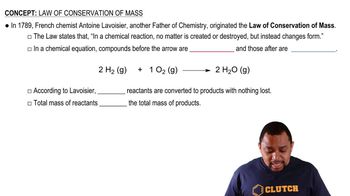Nitrogen 1N22 and hydrogen 1H22 react to form ammonia 1NH32. Consider the mixture of N2 and H2 shown in the accompanying diagram. The blue spheres represent N, and the white ones represent H. (a) Write the balanced chemical equation for the reaction.
Write 'true' or 'false' for each statement. (a) We balance chemical equations as we do because energy must be conserved.

Verified Solution
Key Concepts
Conservation of Mass

Chemical Equations

Energy Conservation in Reactions

Nitrogen monoxide and oxygen react to form nitrogen dioxide. Consider the mixture of NO and O2 shown in the accompanying diagram. The blue spheres represent N, and the red ones represent O. (a) How many molecules of NO2 can be formed, assuming the reaction goes to completion?
Nitrogen monoxide and oxygen react to form nitrogen dioxide. Consider the mixture of NO and O2 shown in the accompanying diagram. The blue spheres represent N, and the red ones represent O. (c) If the actual yield of the reaction was 75% instead of 100%, how many molecules of each kind would be present after the reaction was over?
Write 'true' or 'false' for each statement. (b) If the reaction 2 O3(g)S 3 O2(g) goes to completion and all O3 is converted to O2, then the mass of O3 at the beginning of the reaction must be the same as the mass of O2 at the end of the reaction.
A key step in balancing chemical equations is correctly identifying the formulas of the reactants and products. For example, consider the reaction between calcium oxide, CaO(s), and H2O1l2 to form aqueous calcium hydroxide. (b) Is it possible to balance the equation if you incorrectly identify the product as CaOH1aq2, and if so, what is the equation?
Balance the following equations: (c) Al(OH)31s2 + H2SO41l2¡Al2(SO4)3(s) + H2O(l)
